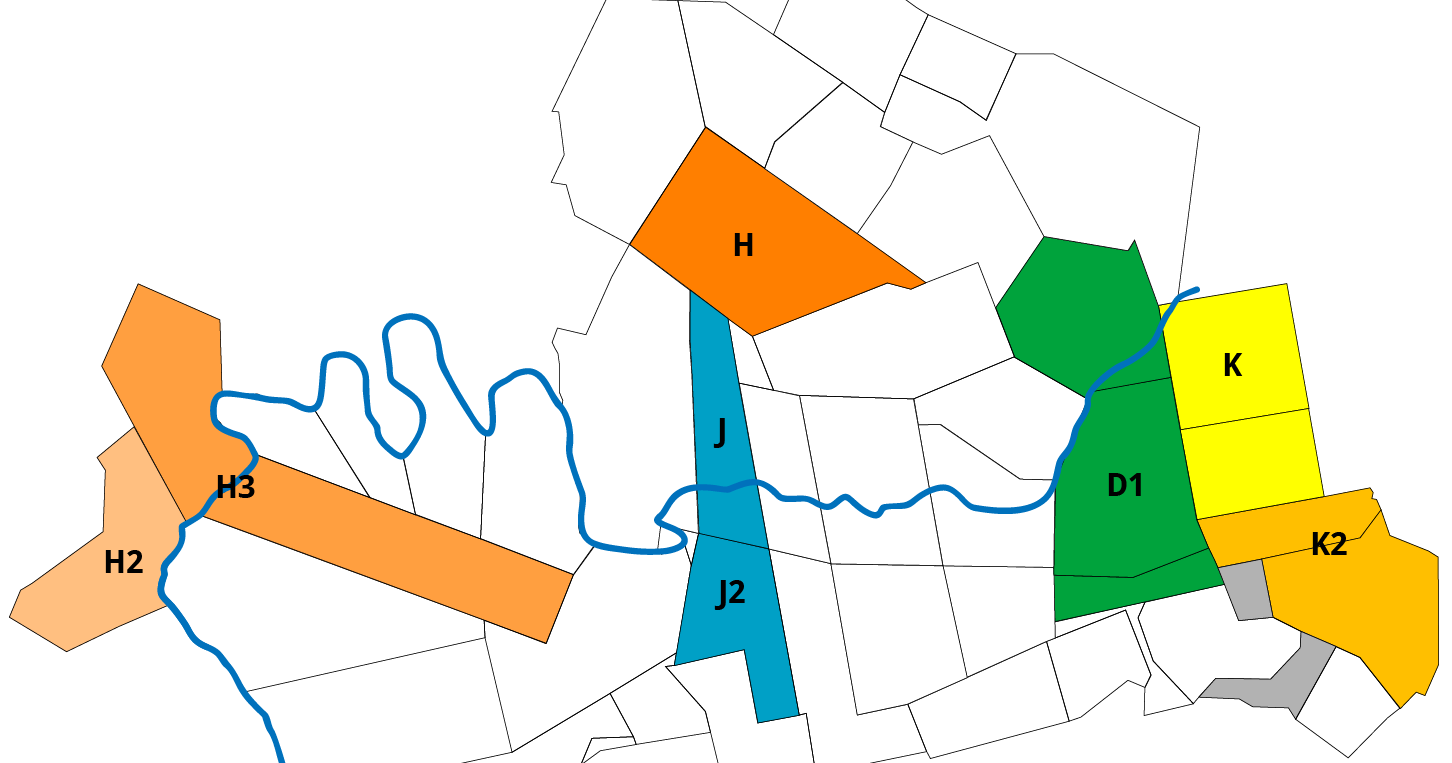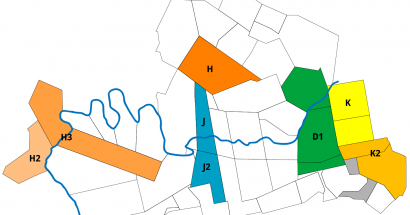Who Were the Byerland Hoovers?

If you’ve been following my Huber/Hoover research, you may have seen me refer to some of them as “Byerland Hoovers.” Who were they? And why am I calling them the “Byerland Hoovers?”
The Byerland Hoovers were the earliest Hoover families to appear in the Lancaster County tax records. They were all Mennonites who settled in Conestoga and Pequea townships along Pequea Creek. They are called the Byerland Hoovers because of their proximity to the Byer/Boyer Mennonite Meeting House.1
Joanne Hoover coded these Hoovers in her research as follows:
- [H] Woolrich Hoover
- [J] Jacob Hoover
- [K] Henry Hoover
- [D1] Jacob Hoover
[H] Woolrich Hoover died prior to 23 Jun 1759 when his heirs sold his property (orange tract marked H) to his eldest son Johannes Hover.2 He likely died in 1757 as an inventory was filed for his estate that year. He was listed amongst other immigrants who had been in Pennsylvania since 1718 in an 1729 naturalization list.3
[J] Jacob Hoover was also likely in Pennsylvania by 1718. He was assessed £10 on his property (blue tract marked J) in 1720.4 His land went to his son John who patented it and an adjoining tract (see J2). This land remained with John’s descendants for many, many years.
Joanne Hoover includes only one Henry Hoover and includes all the [K] and [K2] tracts as belonging to one man. Based on my land research, I believe there were two Henry Hoovers. [K] Henry Hoover died in 1757 and left his land (yellow tracts marked K) to his son John Hoover and daughter Elizabeth (Hoover) Boyer.5
[K2] Henry Hoover and his wife Catharine divided their property (yellow-orange tracts marked K2) between their sons John and Jacob Hoover in 1767.6 I traced this land through deeds from the children of Jacob (d. 1788) and John (d. ca 1810).
Joanne Hoover presumed that [H] Ulrich, [J] Jacob and [K] Henry “were the brothers named in the York County, Pennsylvania, will written Feb 15, 1771 by Christian Hoover who died without issue.”7 I have not been able to prove or disprove this theory. The fact that Christian named Johannes Huber and Johannes Line—two names seen often in Conestoga/Martic townships—as trustees of money Christian wanted paid out to the surviving children of his brothers Jacob, Ulrich, and Henry makes it a tantalizing possibility.
[D1] Jacob Hoover was the son of Hans Huber of Earl Township. His descendants are documented in the book The Huber-Hoover Family History by Harry M. Hoover.
There were other tracts in this same general location that belonged to Hoovers.
The two tract in lighter orange—H2 and H3—may have been purchased by sons of [H] Woolrich Hoover. [H2] was purchased by John Hoover from Jacob Eshleman in 1754.8 He had patented 25 acres just to the west in 1752.9
Part of [H3] was purchased by Ulrich Hoover [Jr.?] from the heirs of Henry Line in 1771.10 Ulrich’s eldest son sold this property to his step-father Christian Huber in 1788 and to Abraham Kendig in 1789.11
The two gray tracts also belonged to Hoovers. The top one was warranted in 1803 and patented in 1811 to Martin Huber. I am not sure if this Martin was the grandson of [D1] Jacob Hoover or the grandson of [K2] Henry Hoover. The boot-shaped tract was warranted to Jacob Hoover in 1796 and patented to him in 1803. He may have been the son of [H3] Ulrich Hoover (one survey showed this tract as being of Ulrich Hoover), the son of [D1] Jacob Hoover or the grandson of [K2] Henry Hoover. Without information on the subsequent transfer of these properties it’s difficult to determine the owner’s identity.
So, these are the families that make up the “Byerland Hoovers.”
Footnotes
- Hoover, Joanne M., “Hoover Three Generations: An Update,” Mennonite Family History, October 2001, page 147. ↩
- Jacob Hover et al to John Hover (1759), Lancaster County Deed Book H: 92-93, online, Lancaster County Recorder of Deeds. ↩
- Eshlemen, H. Frank, Historical background and annals of the Swiss and German pioneer settlers of Southeastern Pennsylvania (s.n., 1917), page 233. ↩
- Eshleman, H. Frank, “Assessment Lists and other Manuscript Documents of Lancaster County Prior to 1729,” page 171. ↩
- Henry Huver last will and testament (1757), Lancaster County Will Book B1:282-283, Pennsylvania State Archives, records group 47, roll 2352 ↩
- Henry Hoober & wife to John Hoober (1767), Lancaster County Deed Book P3: 584—587, online, Lancaster County Recorder of Deeds; and Jacob Huber Exors to Adam Gochenauer (1790), Lancaster County Deed Book 17:657, online, Lancaster County Recorder of Deeds. ↩
- Hoover, Joanne M., “Hoover Three Generations: An Update,” page 147. ↩
- Jacob Eshleman & ux to John Hoover (1754), Lancaster County Deed Book D:453-454, online, Lancaster County Recorder of Deeds. ↩
- Michael Hess survey (1752), Pennsylvania Copied Survey Book A50:293, Pennsylvania State Archives, Records of the Land Office, Records Group 17, Copied Surveys, Series #17.114, Harrisburg, Pennsylvania; survey order returned to John Hoover by warrant 6 Mar 1752. ↩
- Barbara Line & al to Ulrich Huber (1771), Lancaster County Deed Book II:353-358, online, Lancaster County Recorder of Deeds. ↩
- Christian Huber & ux to Jacob Huber (1788), Lancaster County Deed Book II:431-434, online, Lancaster County Recorder of Deeds; and Jacob Huber to Abraham Kendich (1789), Lancaster County Deed Book MM:678-683, online, Lancaster County Recorder of Deeds. ↩
Cite This Page:
Kris Hocker, "Who Were the Byerland Hoovers?," A Pennsylvania Dutch Genealogy, the genealogy & family research site of Kris Hocker, modified 9 May 2012 (https://www.krishocker.com/who-were-the-byerland-hoovers/ : accessed 31 Mar 2025).
Content copyright © 2012 Kris Hocker. Please do not copy without prior permission, attribution, and link back to this page.
2 Replies to “Who Were the Byerland Hoovers?”
Comments are closed.


Allan, based on deeds and other records, I believe so, yes.
Henry Hoover (K) had two children that he named in his will (1757)—John Hoover and Elizabeth (Hoover) Boyer. He left his property to his two children to be divided equally between them. Elizabeth and her husband John Boyer sold their share to her brother, John. The Boyers eventually settled in York County.
John Hoover (K) and his wife Anna had children:
John died in 1799, naming as executors his friend John Huber and son Henry Huber. They sold 144 acres of John’s land to Henry Bowman in 1799.
Henry and Catharine (Good) Hoover divided their land between their two sons John and Jacob. They also had a daughter (name unknown) who was married to a Jacob Huber, possibly a neighbor.
Jacob (K2) and his wife Barbara had children:
John’s will (1788) decreed that his land was to be sold once his youngest son turned 16—it was sold 25 Aug 1790. His brother John and brother-in-law Jacob were his executors.
There is an inventory for Barbara Hoover of Martic township, possibly Jacob’s wife, in 1810 and an account in 1813 with administrators John and Martin Hoover.
John Hoover (K2) and his wife Mary had children:
John died intestate with two tracts of land, both of which were sold to him by Henry & Catharine Hoover. His son John received the land and sold 12 acres to his brother Abraham. After John’s death without heirs sometime between 17 Nov 1815 and 25 Jul 1818, his property descended to his siblings.
Kris
If there are two Henry Hoovers (K) and (K2), have you sorted out who their children are?